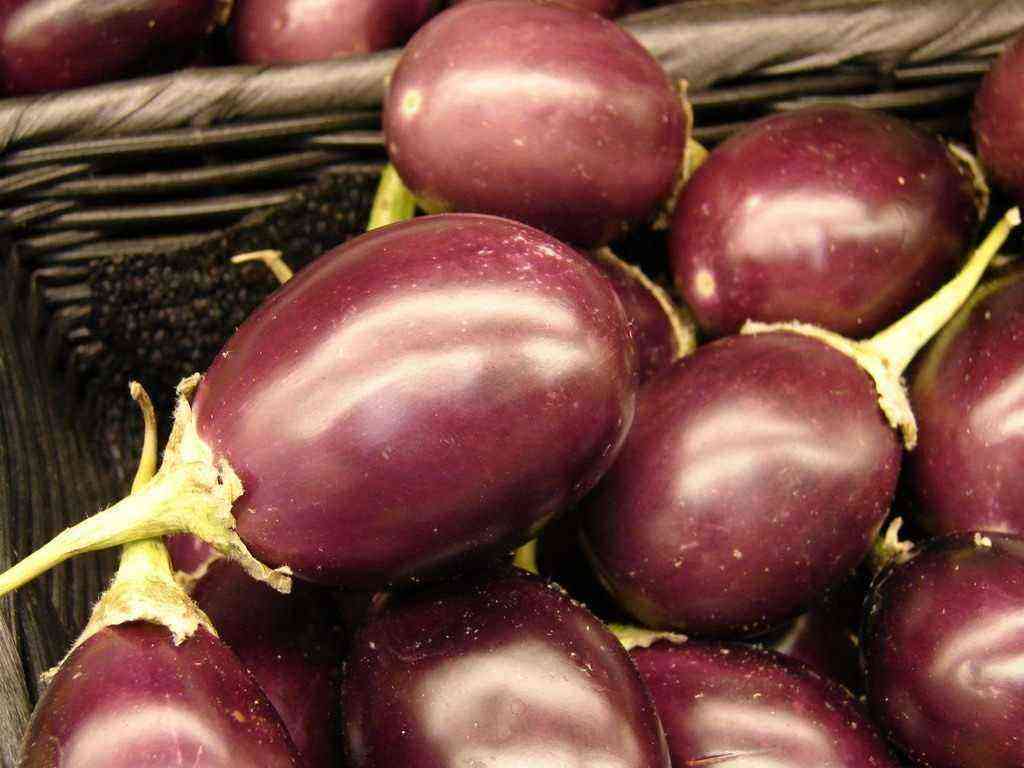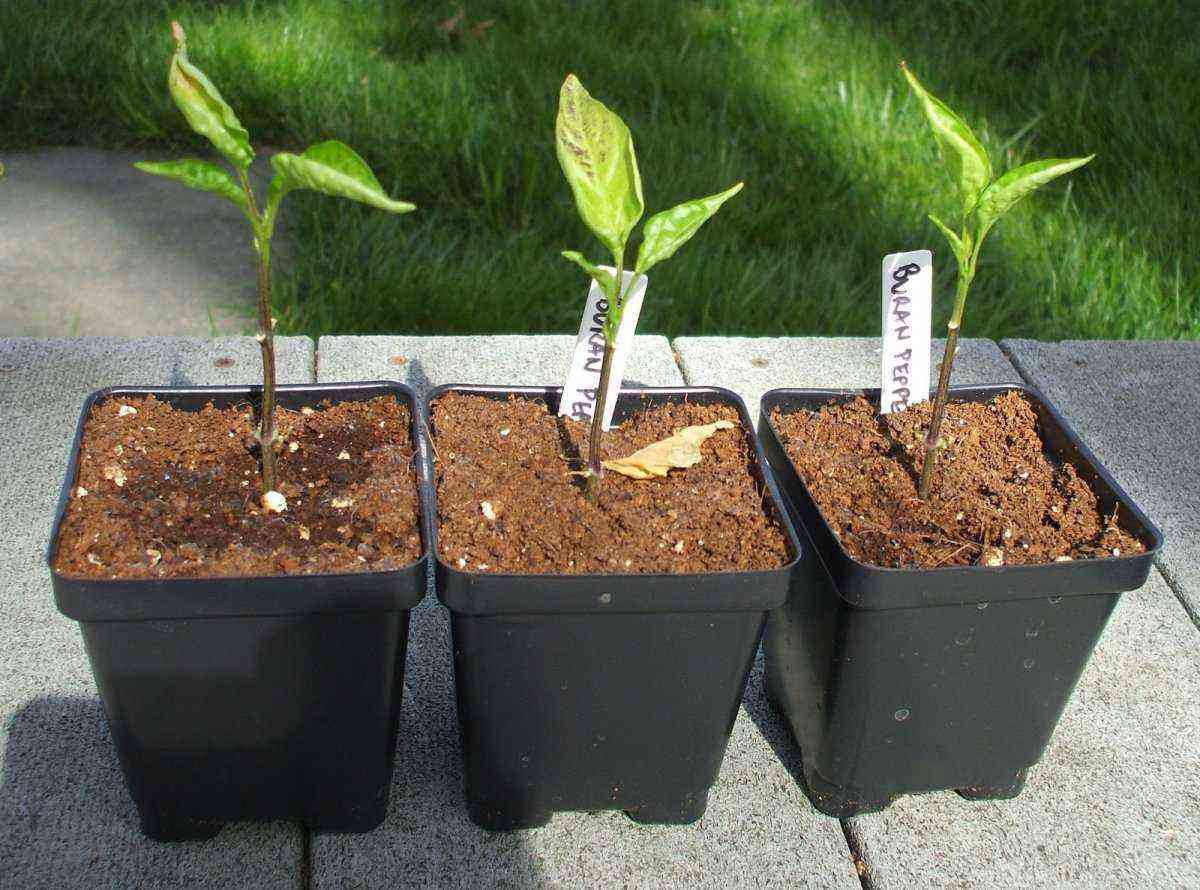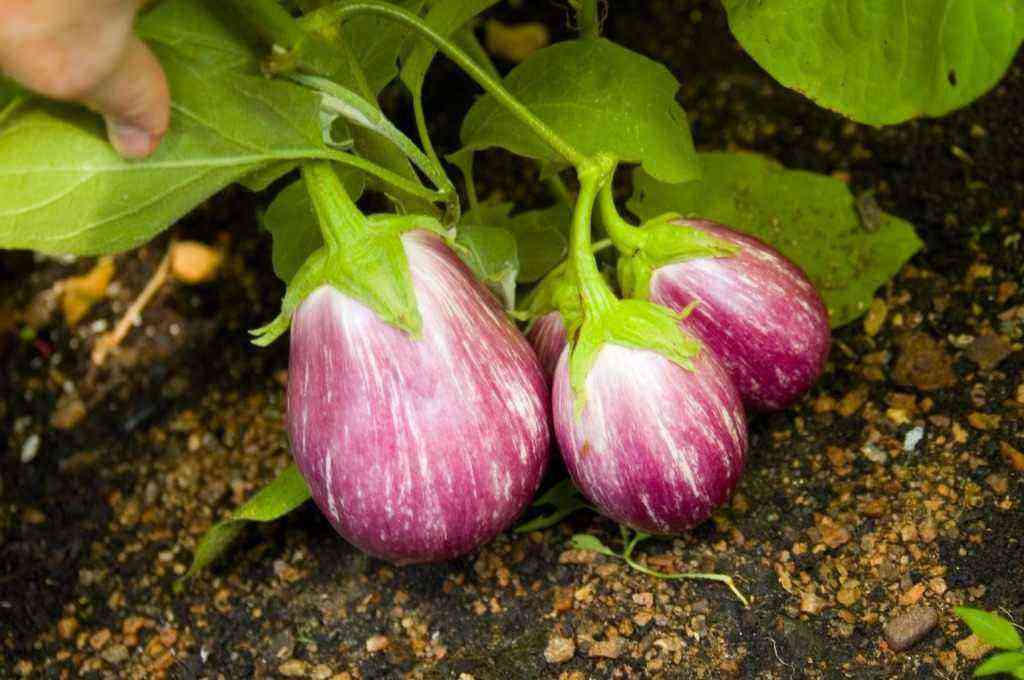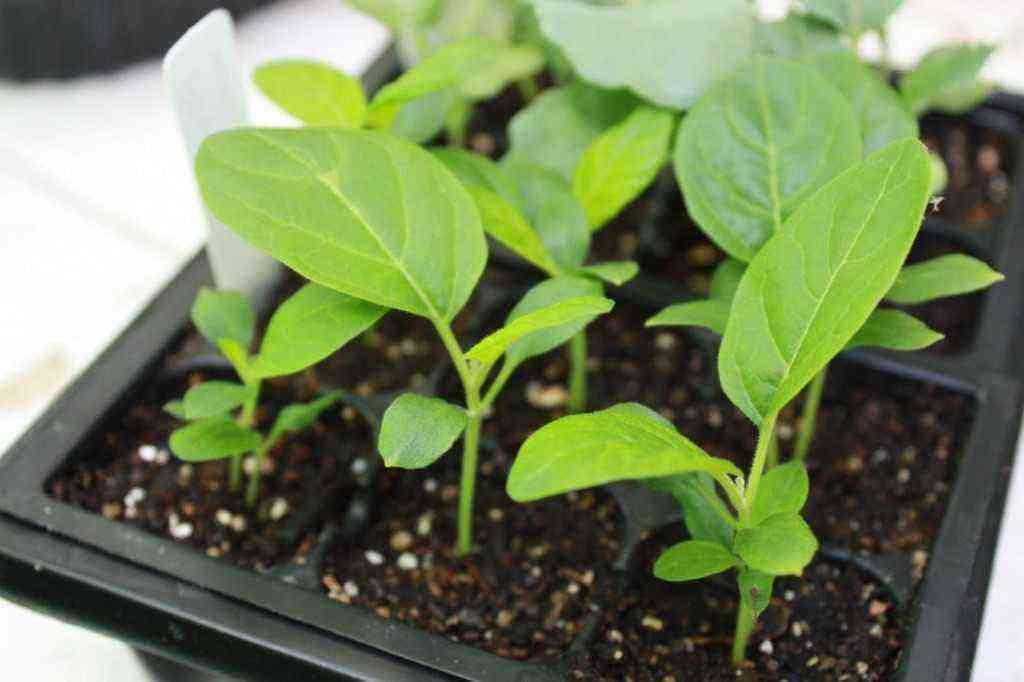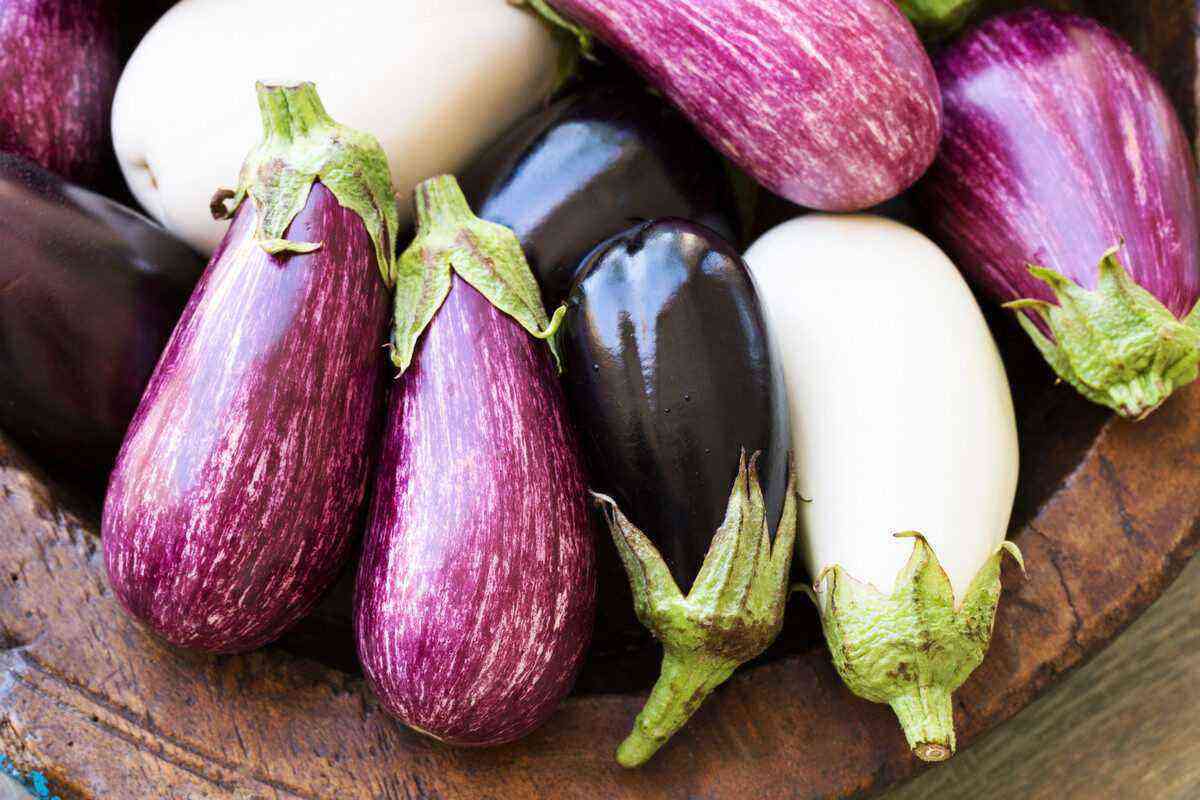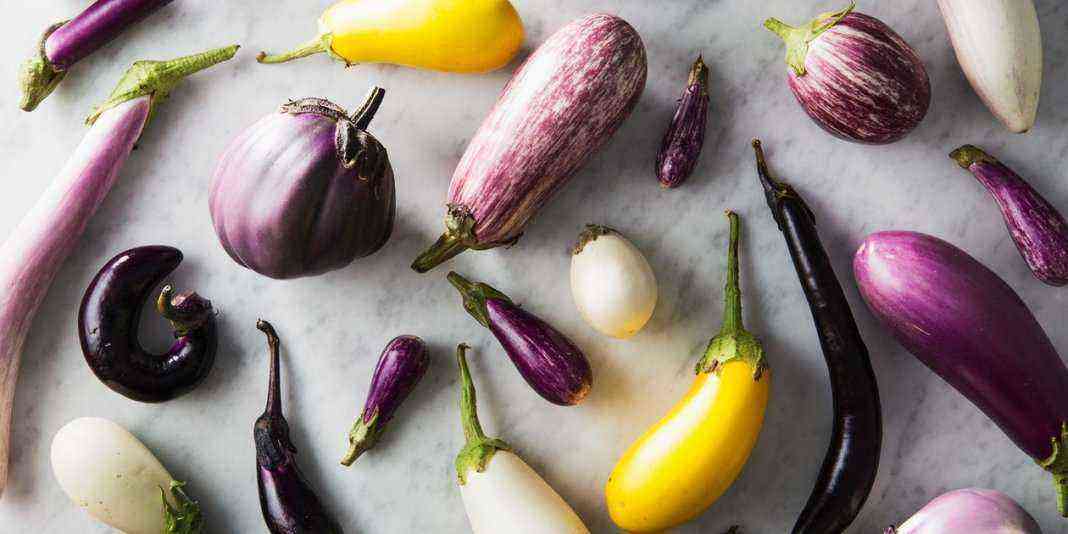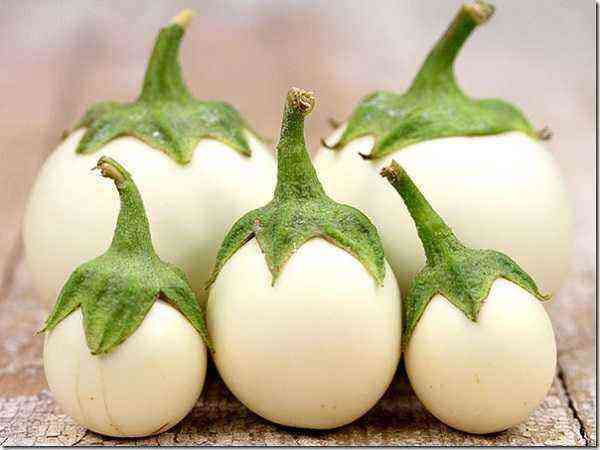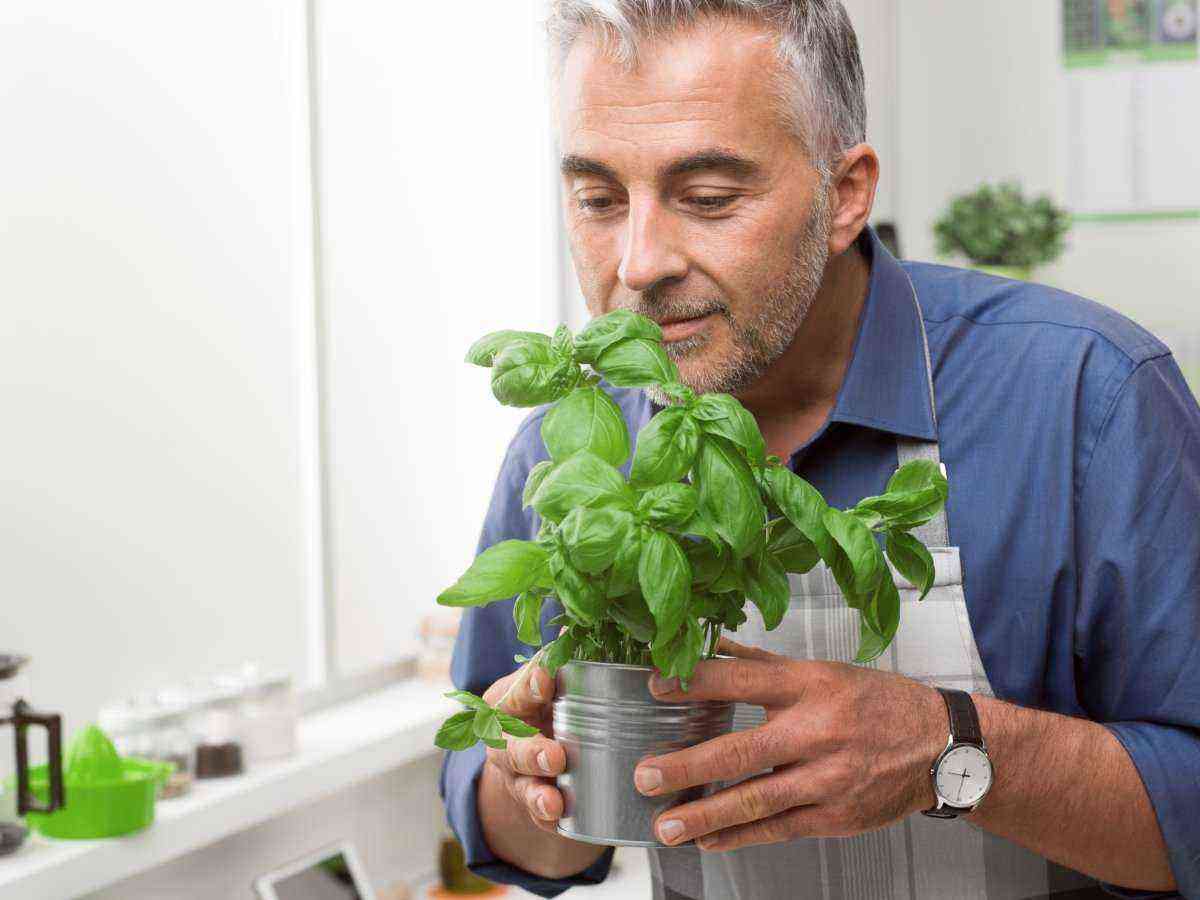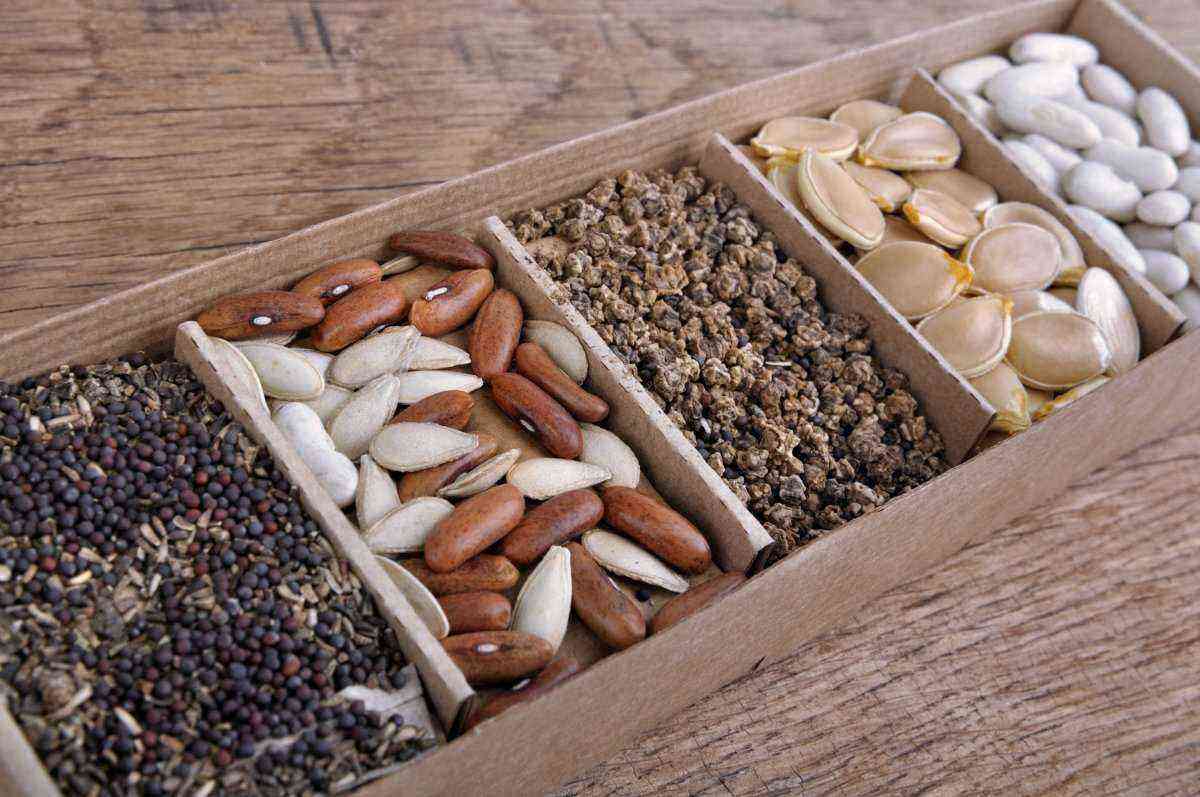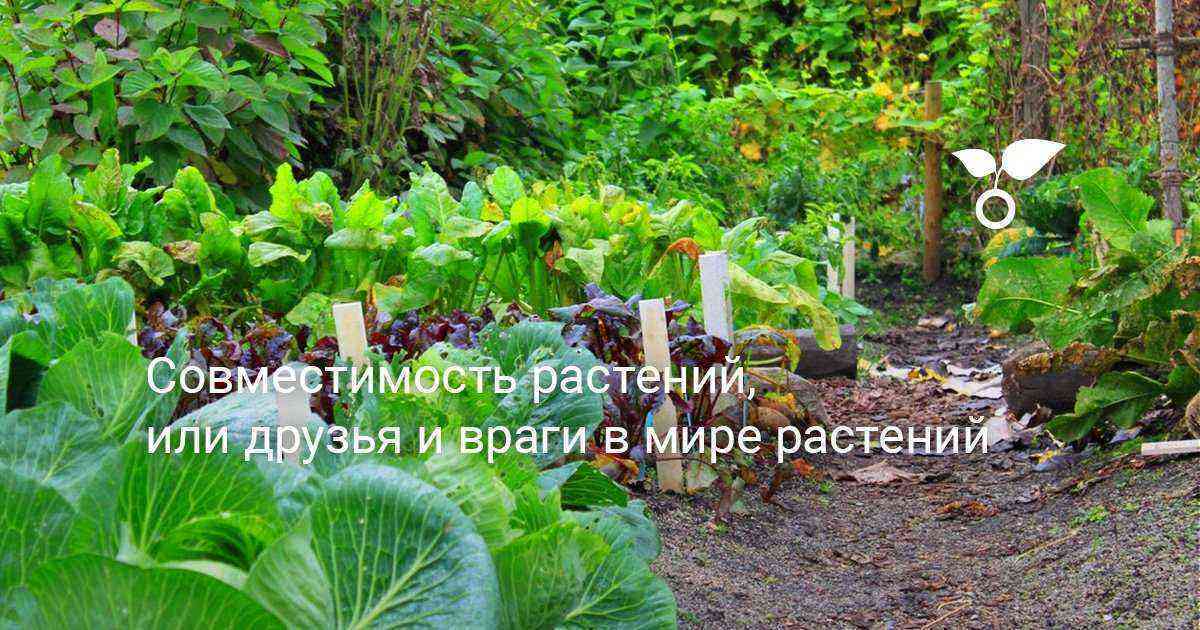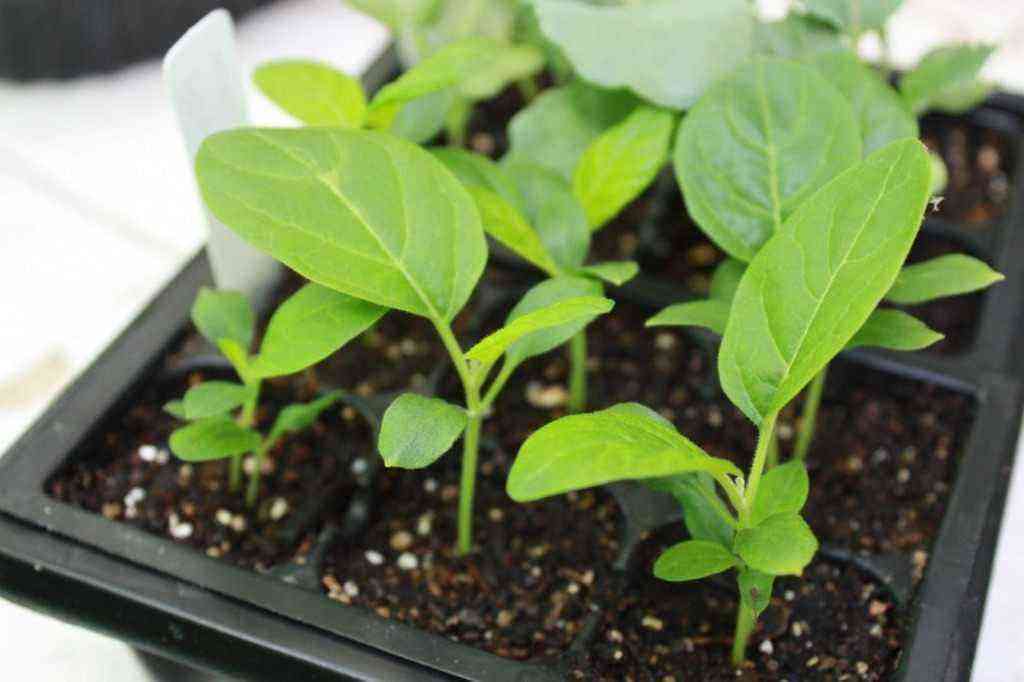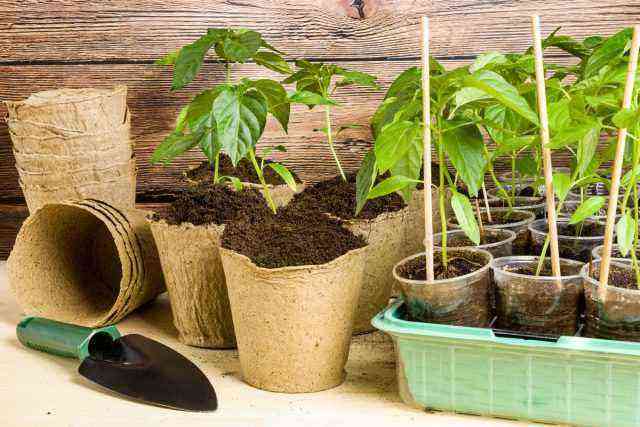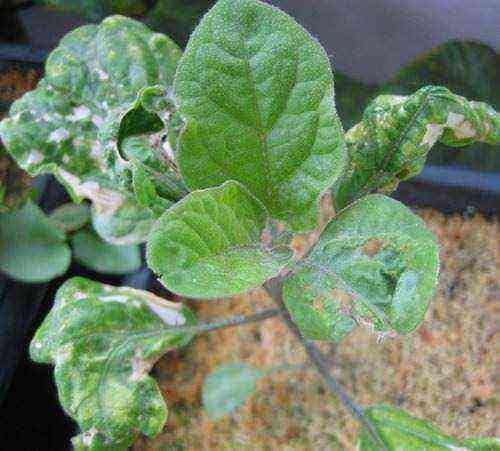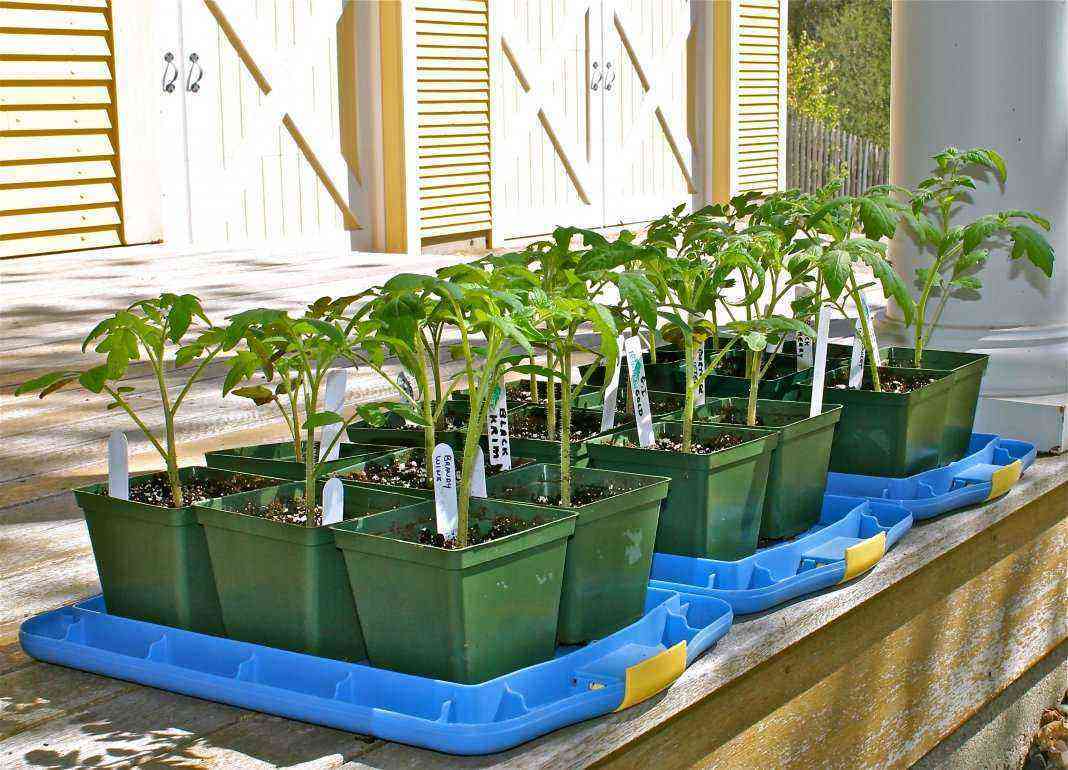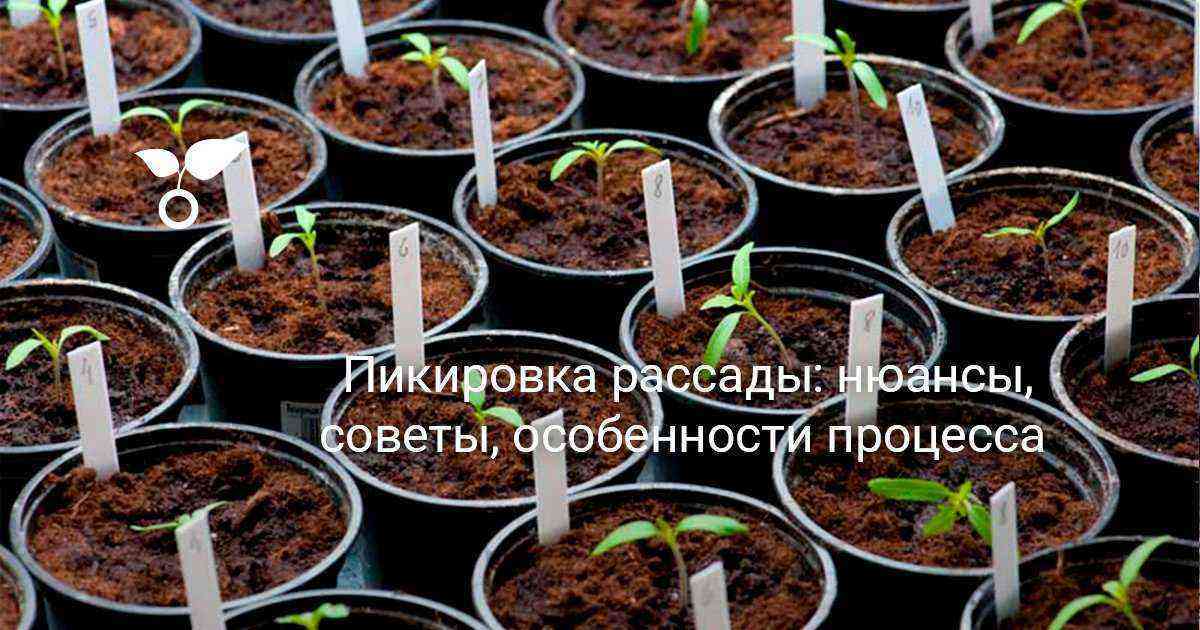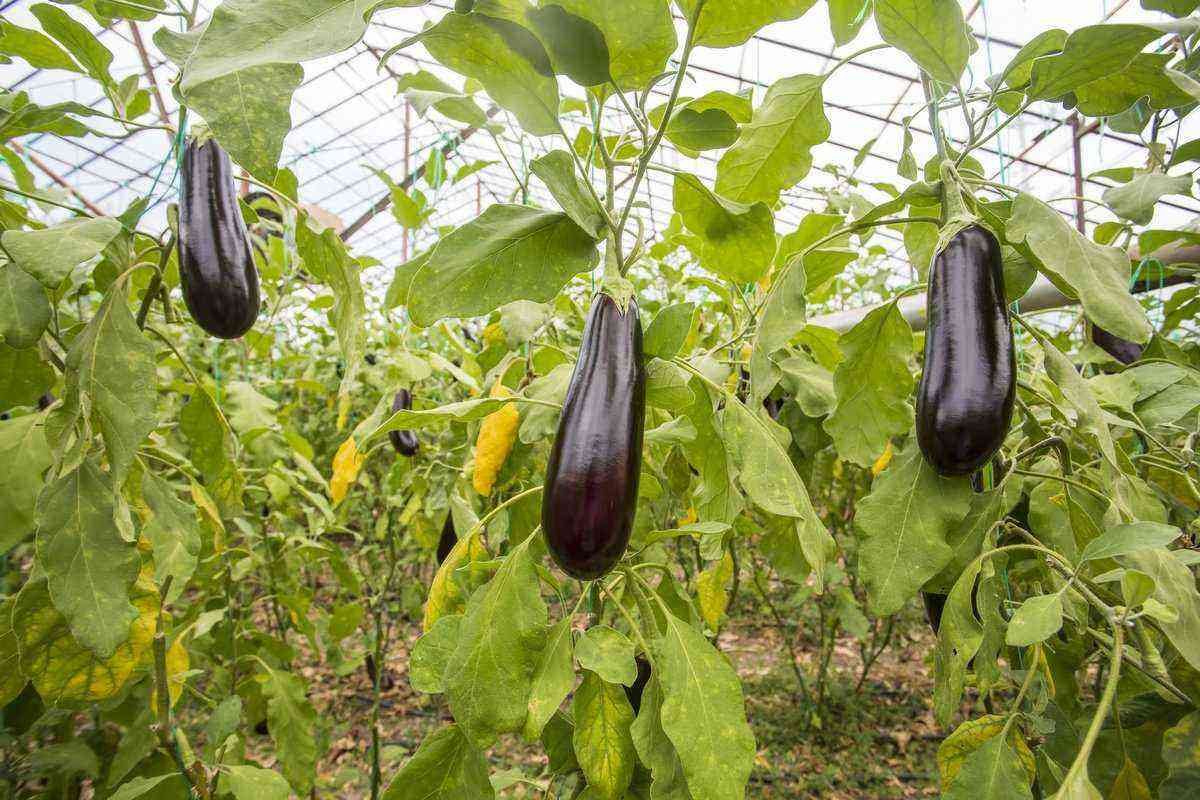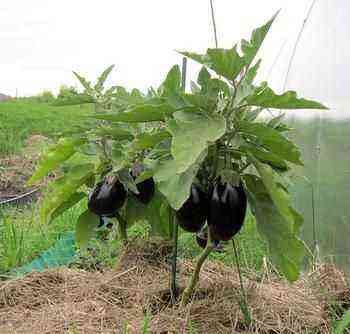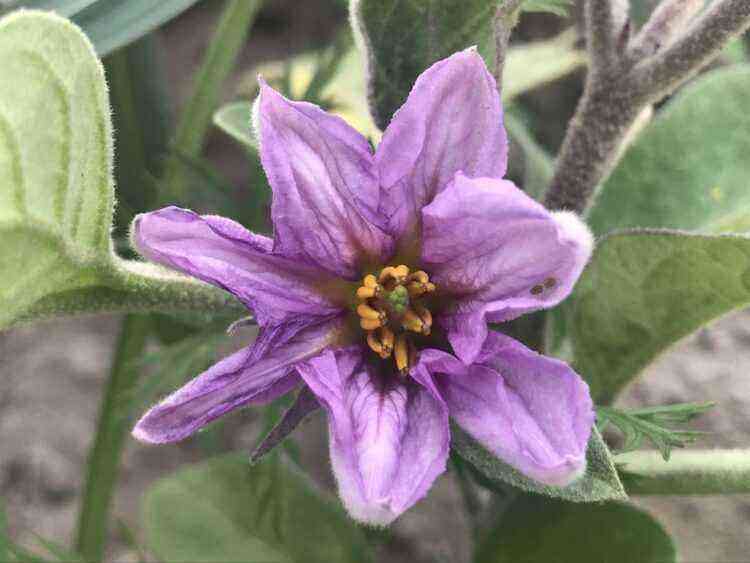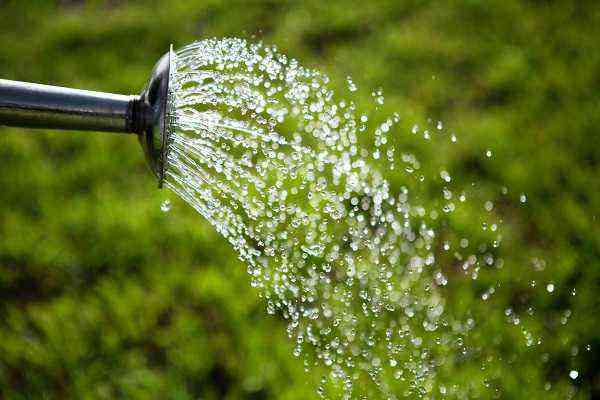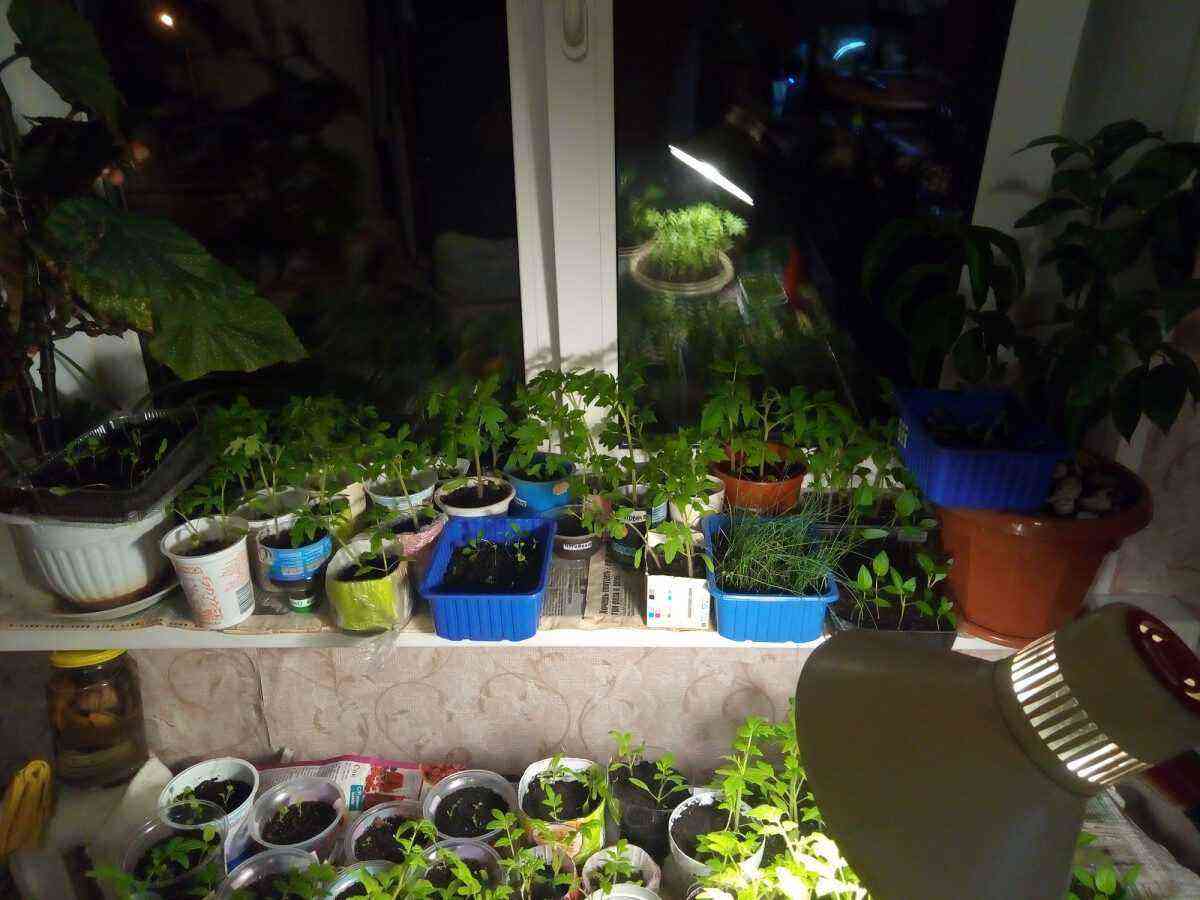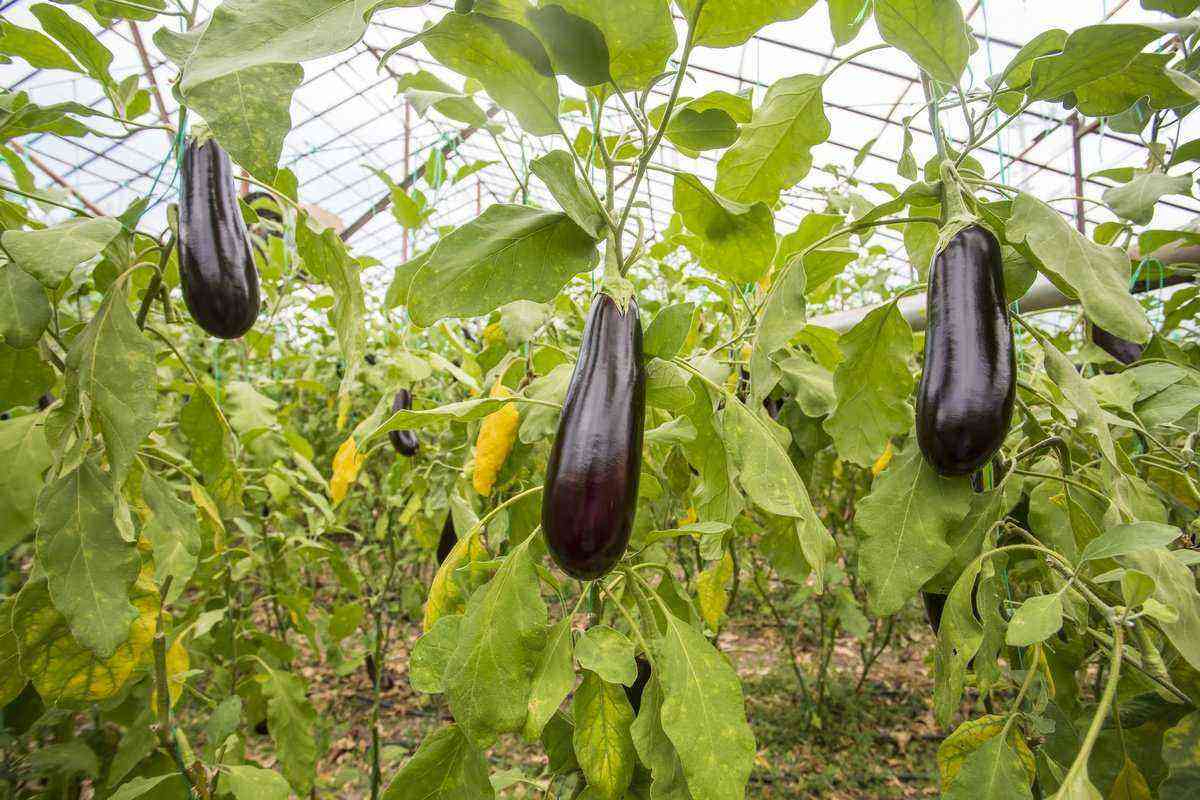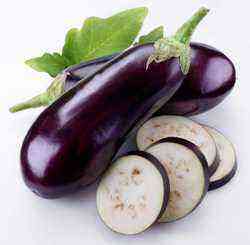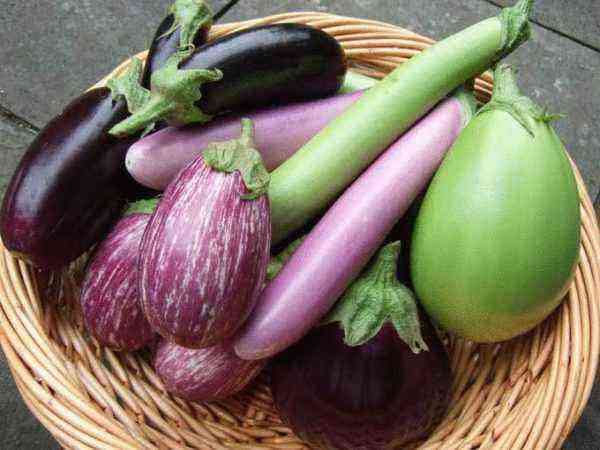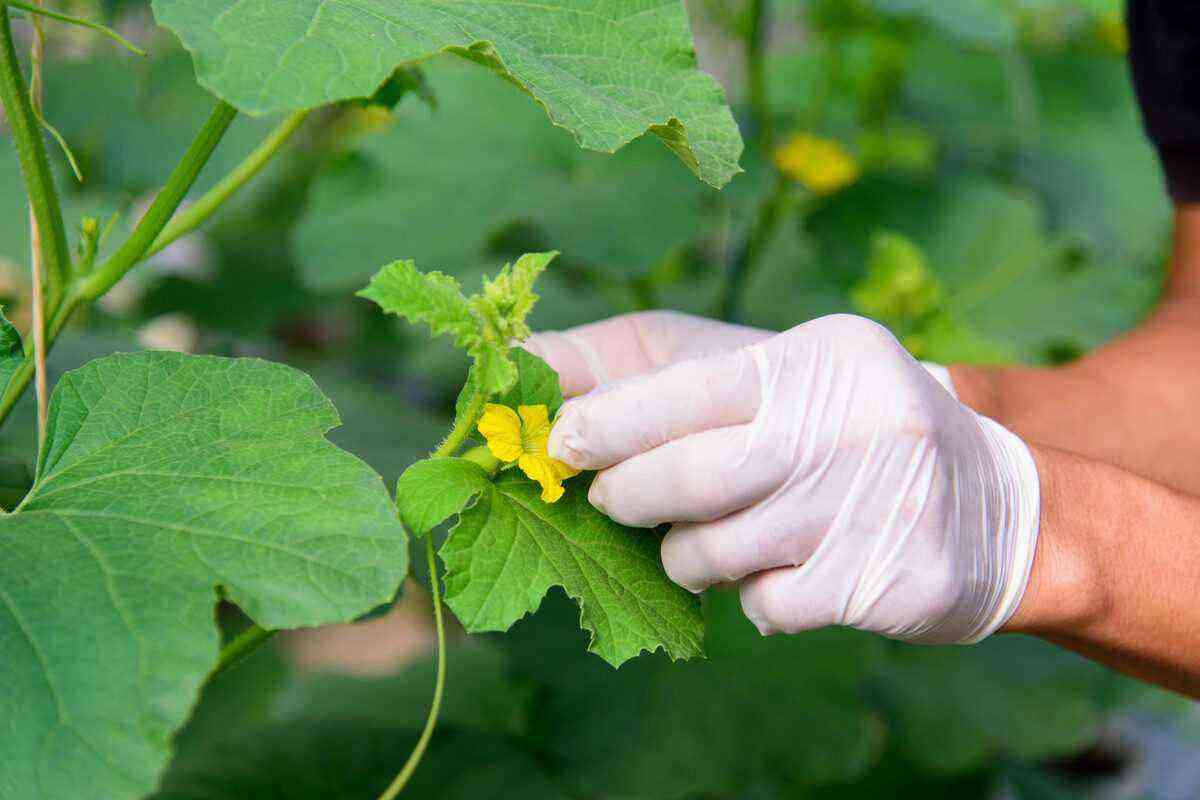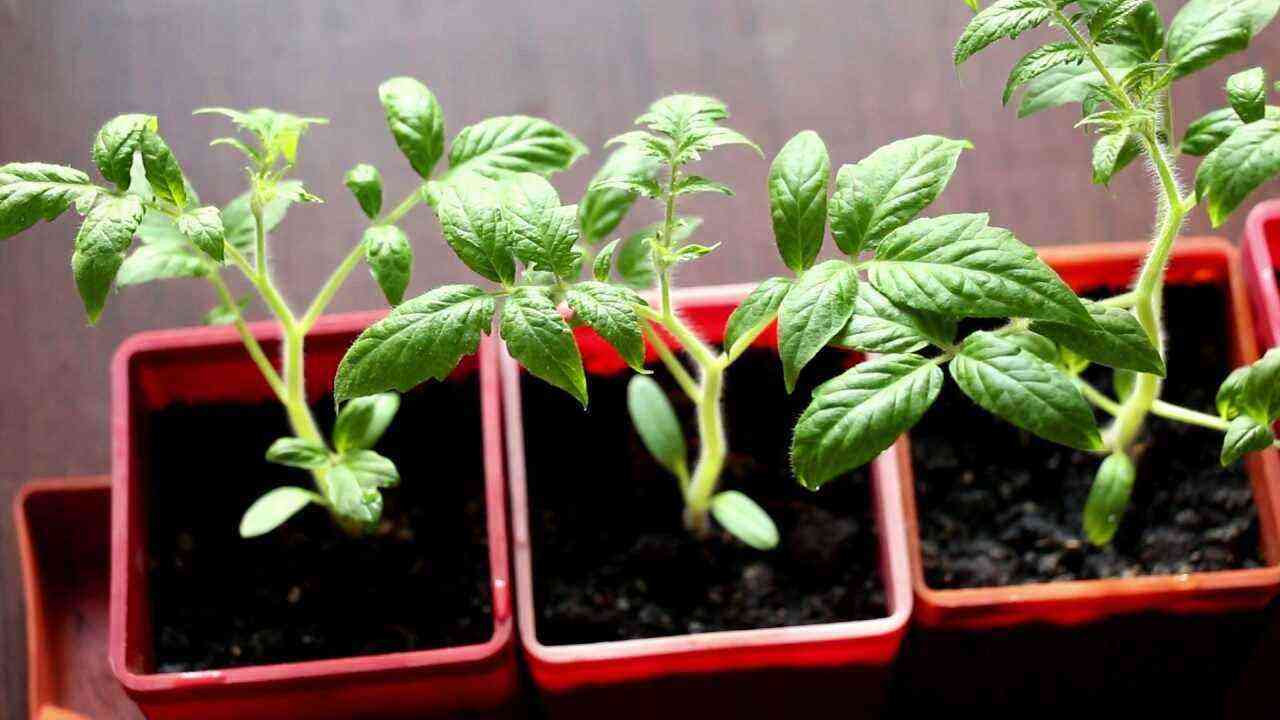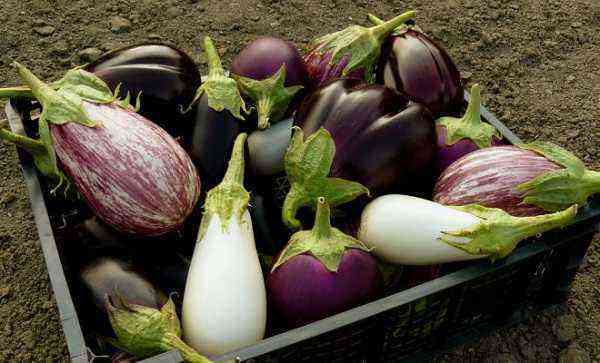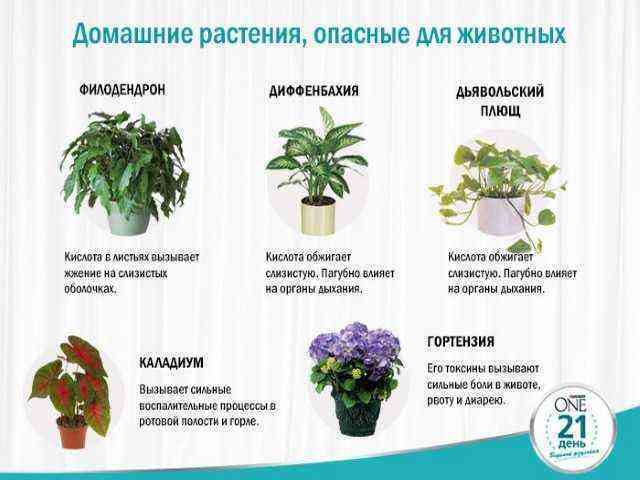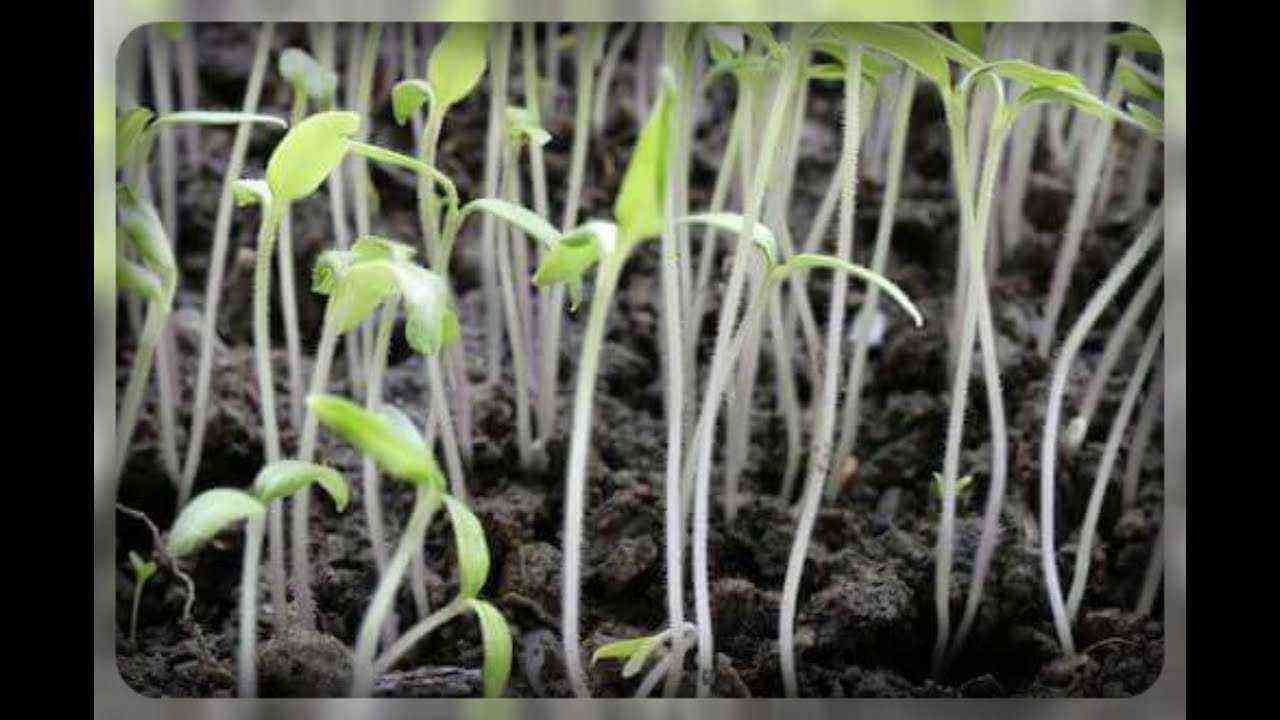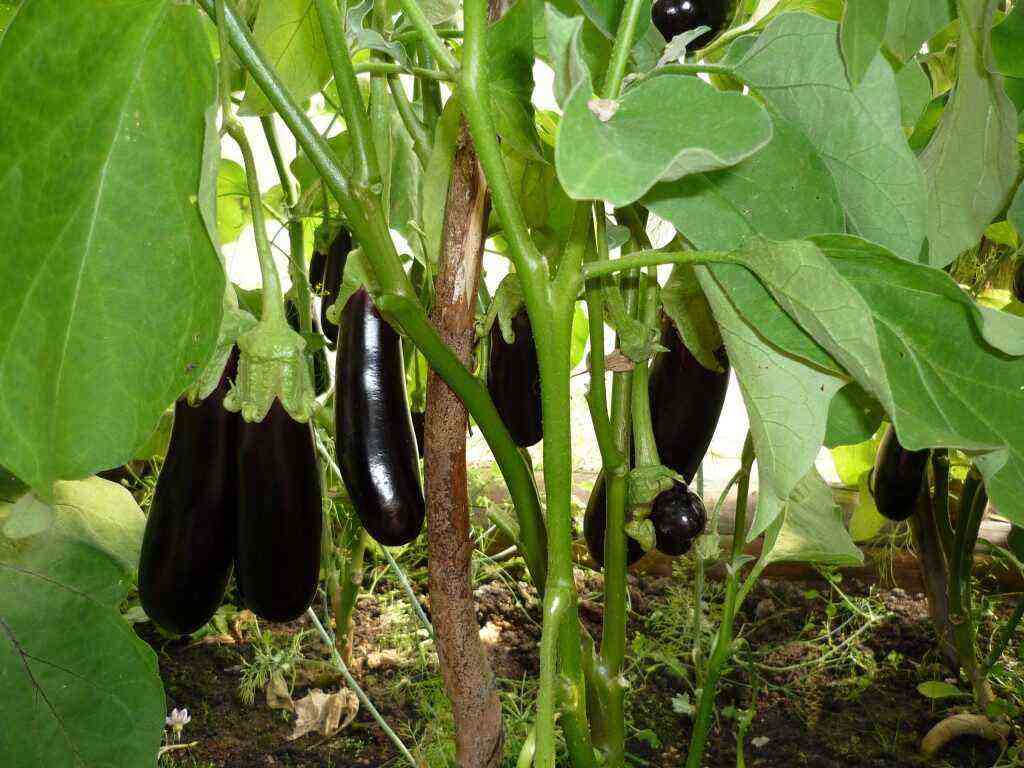Eggplants require a sunny but relatively short day, medium-warm temperatures without sweltering heat, a sufficient amount of moisture, but without flooding the root system. It is quite difficult to provide such conditions in the open ground of most regions of Russia. Therefore, earlier eggplants were grown only in protected ground conditions, where the conditions necessary for this culture were artificially created. With the development of breeding, it became possible to grow eggplants in open ground not only in the southern regions of Russia and the CIS countries, but also in the middle lane.
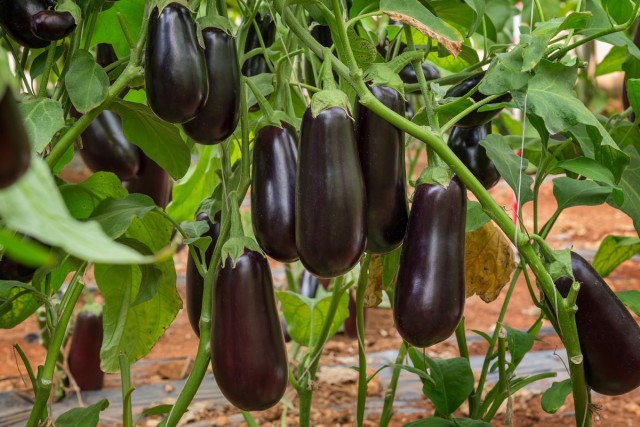 How to grow eggplant outdoors
How to grow eggplant outdoors
Read also our material Eggplant in a greenhouse – growing rules and the best varieties.
With the correct use of agricultural practices, the beloved “blue ones” will delight gardeners with a harvest even in regions of Russia that are unfavorable for eggplants, according to climatic conditions, including the North-West of the European part: the Leningrad Region, certain regions of Siberia and the Urals.
Contents:
Preparing the eggplant bed
The best predecessors of eggplant are early cabbage, legumes, cucumbers, carrots, onions of various types, melons, zucchini, beans. It is impossible (due to the same diseases and pests) to grow eggplant after nightshade (tomatoes, potatoes). The culture needs temporary isolation, that is, a return to its former place of cultivation no earlier than in 3-4-5 years.
For eggplant, loamy or sandy soils are optimal. The culture will also grow on heavy soils if it is fluffed up by the constant application of fresh manure, agrovermiculite, sand, humus, over-aged sawdust (not coniferous) or other materials that increase the air and water permeability of the soil.
Eggplants need a plot in the crop rotation with good lighting. Shading by tall crops or vegetables on a trellis (cucumbers, beans) is not allowed.
Eggplants take a large amount of nutrients from the field with the harvest, so the soil for this crop is thoroughly seasoned with organic and mineral fertilizers.
For the autumn “refueling” use the autumn sowing of green manure and their subsequent incorporation or contribute to 1 sq. m area of 6-10 kg of humus, mature compost. Add 200-250 g of wood ash and 50-60 g of nitrophoska.
Read our material What green manure to sow in the fall?
The soil is dug up on a full bayonet of a shovel to remove the hard (for tender eggplant roots) sole, which is formed during constant shallow digging (15-20 cm). It is more practical to dig in late autumn. During late digging, some of the bear nests wintering in the soil are destroyed.
Spring soil preparation for eggplant
If, due to the prevailing circumstances, the site did not have time to fertilize since the fall, you can sow green manure in the spring for the future eggplant bed.
Read our article What green manure to sow in the spring?
Or, instead of green manure, add humus with the addition of mineral fertilizers in the same doses as in autumn.
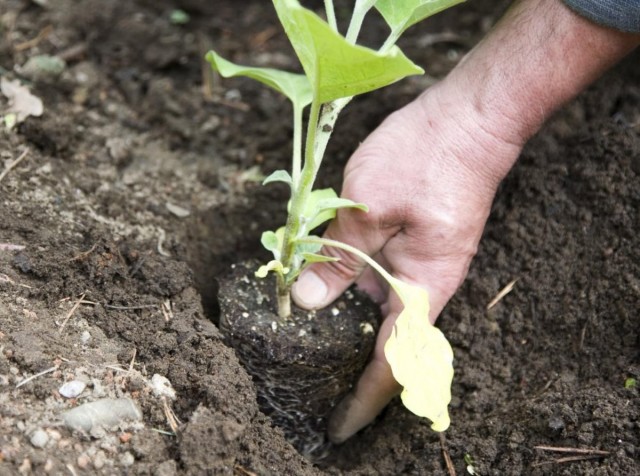 Planting seedlings in open ground in the southern regions is not difficult. © cellcode
Planting seedlings in open ground in the southern regions is not difficult. © cellcode
Planting seedlings in open ground
About growing eggplant seedlings, read our detailed material Growing eggplant seedlings.
When to plant eggplant seedlings in open ground?
Planting eggplant seedlings in open ground in the southern regions is not difficult. The soil warmed up to +17…+18°С in the root layer by the middle-third decade of May and the air temperature within +18…+24°С create optimal conditions for young seedlings of seedlings.
The age of eggplant seedlings can be 65-70 days. By this period, they will have a well-developed root system – 5-8 developed leaves and 1-2 buds.
In regions with a temperate climate, additional measures are needed to prepare the beds for planting eggplant seedlings. If the soil is cold, then the beds are raised by 30-40 cm with bulk soil. In autumn, it is advisable to lay semi-rotted sod and other materials in the garden bed, which, decomposing, will increase the temperature of the soil.
Eggplants in the middle lane are planted in open ground in the first decade of June, and sometimes later. You can use for planting (unlike other vegetables) seedlings 70-75-80 days old, having at least 3-5-7 developed leaves.
How to plant eggplant seedlings?
So that the plants do not shade each other, it is more practical to use an ordinary planting scheme, placing seedlings in a row after 45-60 cm, and in row-spacing after 60-80 cm, depending on the habitus of the future bush.
In holes 10-15-18 cm deep, a handful of wood ash and a tablespoon of superphosphate are mixed. Seedlings, so as not to damage the delicate brittle roots of eggplant, are planted with a lump of moist soil. The roots in the hole should not break.
Sprinkle the hole with the seedling with soil, easily crush it (without effort) and water it with warm (+18 .. + 30 ° C) water, you can – with a weak solution of potassium permanganate. Watered eggplant plantings must be mulched with any fine dry mulch (moor peat, 2-3-year-old non-coniferous sawdust, humus, etc.).
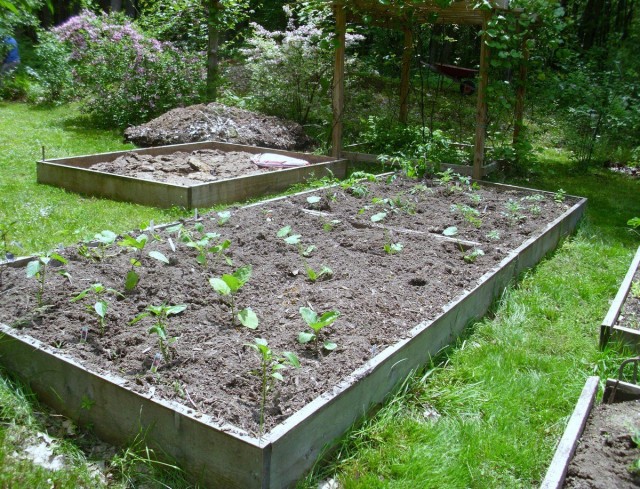 Eggplants love bright sunlight, the duration of which should not exceed 12 hours in the first month. © Bright Spot Farms
Eggplants love bright sunlight, the duration of which should not exceed 12 hours in the first month. © Bright Spot Farms
Outdoor eggplant care
Lighting
Eggplants love bright sunlight, the duration of which should not exceed 12 hours in the first month, and later – 12-14. With a 12-hour light day, eggplants quickly move on to flowering and fruit formation. With a longer daylight hours, they may be limited to the development of a vegetative mass without flowering and fruit set.
Therefore, you should always have covering material on hand to limit the access of light to this culture.
Temperature conditions
Eggplants are very demanding on the temperature regime of the soil and air. The soil should be warmed up not lower than +16°С, its optimum temperature fluctuates within +17…+18°С. Air during the day – up to +18..+24°C and at night within +15…+18°C.
There are varieties that develop normally at an average daily air temperature of + 15 ° C.
Cold prolonged drizzling rains have a detrimental effect on the development of eggplants. A decrease in air temperature to + 12 ° C during the flowering period causes the drop of flowers and ovaries, and a further decrease leads to the death of the culture. Protection from this – watering with heated water, temporary shelters.
Watering eggplant
Irrigation is always carried out with warm, sun-warmed water (in the south), and in regions with a temperate climate and cold soil, irrigation water is heated to + 25 … + 30 ° С. Water eggplant only at the root. When water gets on the leaf surface, the leaves get sick, photosynthesis decreases, the plant stops developing.
The first watering is carried out 10-12 days after planting in open ground. If the weather is dry, hot, then after 7-9 days. The soil should be constantly moist, but not more than 65-70% (the eggplant root system does not tolerate flooding and high soil moisture).
From the phase of flowering and the formation of ovaries, the watering rate is increased by soaking the soil to a layer of 15-20 cm, and watering is carried out once a week (in 1-5 days).
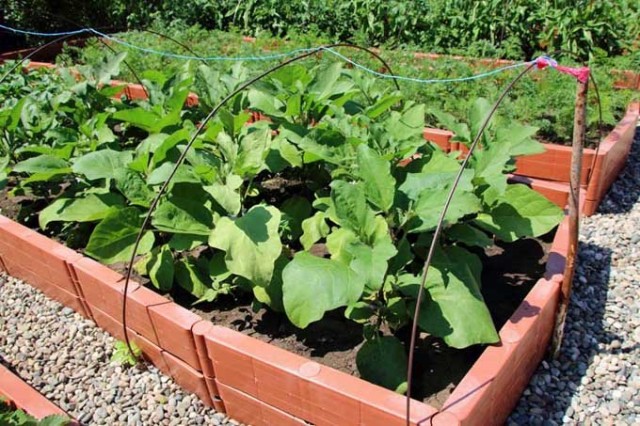 During the growing season, root feeding of eggplants is carried out 1 time in 2-3 weeks. © Gardener’s Path
During the growing season, root feeding of eggplants is carried out 1 time in 2-3 weeks. © Gardener’s Path
Eggplant feeding
During the growing season, root feeding of eggplants is carried out 1 time in 2-3 weeks. Between them, during the period of flowering and the formation of ovaries, the plants are additionally treated by spraying with boric acid, a set of trace elements, and other solutions for foliar top dressing.
The first feeding of eggplants is carried out 10-12 days after planting the seedlings in open ground (landmark: the appearance of a new leaf on the emerging bush). Given that the first month eggplants gain vegetative mass very slowly, fertilizing is carried out with nitrogen-containing fertilizers – Kemira, Kristallin, Mortar, Effekton at the rate of 30-40 g / 10 l of water (1,0-1,5, XNUMX l under the bush).
If these fertilizers are not available, then you can add a solution of ammophos at the rate of 150 g of fertilizer per 10 liters of water.
The second feeding of eggplants in 12-15 days is carried out with a mixture of wood ash, which will replenish the root layer with microelements, and complete fertilizer (nitrophoska or nitroammofoska) at the rate of 20-25 g per bush or 40-50 g / sq. m. area.
In the second top dressing, instead of the proposed mixture, an extract from bird droppings can be added. Insist 2-3 kg of bird droppings for 2-3 days in 10 liters of water, strain, dilute in 10-15 liters of warm water and pour each bush under the root at the rate of 1,0-1,5 liters.
In the phase of the beginning of flowering for feeding eggplants in the open field, it is effective to use nitrophos, diammophos or nitrophoska at 35-40 g / sq. m. area and foliar spraying with a solution of boric acid (dissolve 1 g in 5 liters of hot water, cool and sprinkle the plants).
In the phase of flowering and fruit set, foliar top dressing with microelements or solutions of fermented herbs can be repeated.
With the beginning of eggplant fruiting, top dressing is carried out with a phosphorus-potassium mixture (superphosphate and potassium sulfate) at the rate of 40-50 g / sq. m. area.
Eggplant harvesting is repeated and, in order to maintain fruiting (especially on infertile soils), after the first or second harvest, one more feeding with phosphorus-potassium fertilizers can be carried out.
Currently, the fertilizer market offers a wide range of nutrients to maintain and increase soil fertility, and hence provide vegetable crops with nutrition (complex, complex, organo-mineral, etc.).
In any case, it is not necessary to overfeed eggplants with high doses of fertilizers, especially nitrogen fertilizers, in the second half of the growing season. Plants will then form a large biomass to the detriment of fruit development.
Eggplant weeding
The soil under eggplant should always be loose, moist, without soil crust and weeds. Small loosening, so as not to damage the roots, is carried out on the 2nd day after watering, it is better with raking the soil (hilling up).
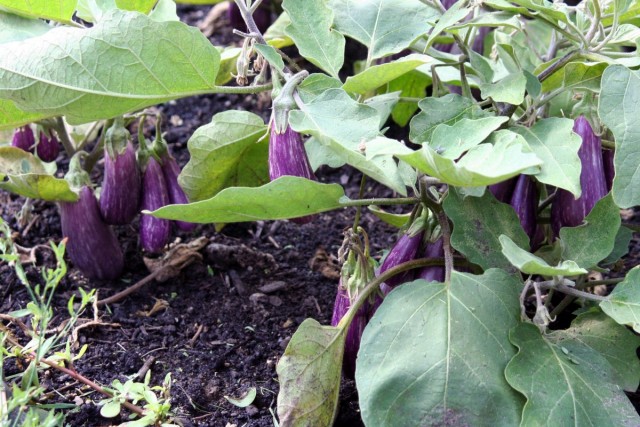 Low-growing and dwarf eggplant varieties do not require bush structuring. © CAESANDRA SEAWELL
Low-growing and dwarf eggplant varieties do not require bush structuring. © CAESANDRA SEAWELL
Bush formation and eggplant pinching
Eggplants do not like unnecessary interference. Therefore, undersized and dwarf varieties do not require structuring the bush. The bush is formed when it reaches 25-30 cm in height.
Late formation of eggplants (removal of large stepchildren with ovaries) severely injures the bush, causes its disease and sometimes leads to death. Examine the bearing (central) stems. Pinch off the stepchildren located in the axils of the leaves, to the first bud. If the plant is poorly developed, then the first bud can be removed. This technique stimulates the development of the root system and stems, positively affects the formation of flowers and ovaries.
Further, when forming eggplant bushes, they act differently.
Early, undersized varieties of eggplant with a small fruit weight (200-250 g), having 2-5 stems, usually do not structure, they only provide them with proper care.
If eggplant variety is early or mid-season and forms a lot of ovaries, and according to the characteristics of the fruits of medium weight (up to 250-400 g), then, regardless of the growing region, up to 20-25% of the flowers are cut off. The remaining flowers form larger fruits. If you leave all the flowers, the fruits will be small and among them there will be many underdeveloped ones.
Tall, branching, large-sized eggplant bushes usually form medium and late varieties, which are grown mainly in the southern regions. Such bushes are formed into 1-2-3 stems and tied to a trellis in several places so that large (up to 450-900 g) fruits do not break off branches.
On each branch of the shoot, 1 ovary is left, and the rest are removed by pinching (it is better to carefully cut them with secateurs). With this formation, each bush will have 5-7-8 fruits weighing up to 1 kg. In eggplant, stepchildren grow slowly and inspection of the bushes can be carried out 1 time in 2 weeks.
Closer to autumn, pinch the tops of eggplant bushes and remove all small fruits. They will no longer grow, but will delay part of the nutrients for their development.
 Before harvest, eggplants are damaged by diseases and pests throughout the growing season. © Karen
Before harvest, eggplants are damaged by diseases and pests throughout the growing season. © Karen
Protection of eggplants in the open field from diseases and pests
Eggplant is a multi-harvest crop. Eggplant fruits are harvested in technical ripeness when they reach standard sizes, color, pulp density (determined by pressing on the fruit) and other characteristic features. But before harvesting, eggplants are damaged by diseases and pests throughout the growing season.
When reusable cleaning, the use of chemical protective agents is prohibited. Therefore, the basis of protection is preventive measures and the use of biological products. Plants can be treated with biological products from the first days after planting in the field until the very harvest.
Eggplants are a “tidbit” for pests, and with the establishment of warm weather, their activity increases sharply. They damage the leaf apparatus, flowers, ovaries, fruits. The greatest harm is caused by aphids, whiteflies, spider mites, thrips, etc.
Biological preparations Bitoxibacillin, Lepidocide, Basamil and others effectively destroy pests.
If the requirements of agricultural technology are violated, plants are often affected by fungal and bacterial rot, viral mosaic. And in this case, the appropriate biological products will help – Gamair, Fitosporin, Planriz, Alirin-B, Baktofit. Biocomplex BTU effectively protects plants.
Remember! Biological products operate at certain temperatures and all the required conditions for breeding, preparing tank mixtures and processing plants. Violation of the recommendations (especially, increasing the concentration of solutions, processing in cold weather, etc.) will not give the expected effect.
In addition to biological products, you can use folk methods of protecting plants from pests and diseases.
Read our detailed material Protecting eggplant from diseases and pests.
The best varieties and hybrids of eggplant for different regions
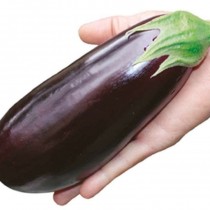 Eggplant “Purple Miracle” F1. © LePlants
Eggplant “Purple Miracle” F1. © LePlants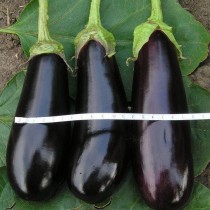 Eggplant “Fabina” F1. © farmerpro
Eggplant “Fabina” F1. © farmerpro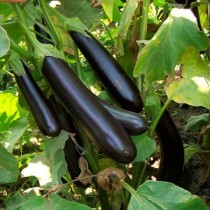 Eggplant “Valentina” F1. © Fermilon
Eggplant “Valentina” F1. © Fermilon
Varieties and hybrids of eggplant for regions with a short warm summer
The main condition for the successful cultivation of eggplant in an unstable and insufficiently warm climate is the use of zoned varieties with a developed system of adaptation to weather disasters and a quick transition to fruiting.
Below are the eggplant varieties and hybrids recommended, according to the State Register of the State Sort Commission of the Russian Federation, for growing in open ground in regions with short warm summers (North-West, Leningrad Region, Urals, Moscow Region, Siberia).
In the climatic conditions of these regions, early and ultra-early eggplant varieties and first-generation hybrids (F1) form fairly high yields. The first harvest of fruits of technical ripeness is obtained in 75-100 days.
Zoned eggplant varieties are resistant to low temperatures, daylight hours, resist a number of diseases well and form a sufficient yield with a fruit weight of 50 to 350 g.
Eggplant “Purple Miracle F1” – little susceptible to the length of daylight hours. Undersized, does not require the formation of a bush. Early ripe – manages to form a crop of 200 g of fruits in 2-2,5 summer months. Resistant to diseases and damage by pests, which means that it does not need frequent protective treatments.
Eggplant “Balagur” – ultra-early, the first harvest in technical ripeness is removed after 75-80 days. The fruits are not large in weight, but the harvest is plentiful due to the formation of a fruit cluster of 3–7 eggplants weighing from 50 to 130 g. Balagur is resistant to rot and tobacco mosaic.
Eggplant “Maksik” F1 – forms miniature bushes up to 60 cm tall, which is very convenient if you need temporary shelters from sudden cold snaps that occur in June. The fruits are quite large up to 180-250 g. m. can be harvested for 2-3 cuts up to 10 kg of crop.
Eggplant “Fabina” F1 – one of the earliest. It takes only 40-50 days from planting seedlings to harvesting the first fruits, which makes it possible to grow eggplants in open beds even in the northern regions. Undersized, up to 60 cm, the bush needs a large area, as it is distinguished by an open type of bush. Resistant to fungal diseases and spider mites. The bush is able to ensure the simultaneous development and ripening of 8-9 fruits.
Of the other varieties and hybrids of eggplant, according to reviews of gardeners in the northern regions and areas with an unstable climate (return frosts, long cold rains, hot but short summer period, etc.), eggplants such as “Valentina” F1, “Alekseevsky”, “Diamond”, “Batai”, “Matrosik”, “Bagheera” F1, “Bibo” F1 and others.
Eggplants for regions with long warm summers
In the regions of Russia (Lower Volga, Caucasus and Transcaucasia) and CIS countries with long warm summers, eggplants are grown both in protected and open ground.
Almost all low-growing early varieties and hybrids of eggplant, large-bush, tall medium and late ripening form consistently high yields with good fruit taste: without bitterness, with delicate pulp, pleasant aftertaste, mushroom aroma.
Among eggplant varieties and hybrids, there are resistant to a complex of diseases or individual diseases, cold-resistant. The formation of a high yield of some varieties is accompanied by large fruits up to 800-900-1000 g (very convenient for preparing caviar), others, relatively small-fruited (100-400 g), are used for pickling, stuffing, and cooking various dishes.
For cultivation in warm regions, you can use all the varieties and hybrids described above, among which eggplants are distinguished by gardeners. “Alekseevsky”, “Black handsome”, “Robin the Hood”, “Bibo” F1, “Purple Miracle” F1, “Fabina” F1 and etc.
Of the medium group, eggplants are the most common. “Diamond”, “Black Moon” F1, “Bagheera” F1 etc. They form a crop for 115-130 days, are unpretentious to growing conditions.
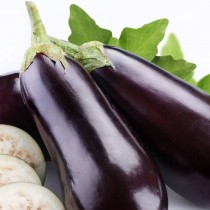 Eggplant “Alekseevsky”. © Fermilon
Eggplant “Alekseevsky”. © Fermilon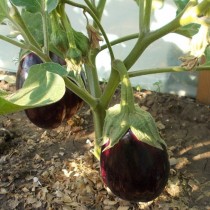 Eggplant “Black Beauty”. © Farmers
Eggplant “Black Beauty”. © Farmers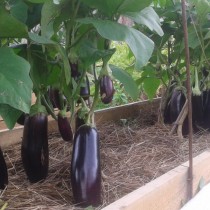 Eggplant “Diamond”. © decorme
Eggplant “Diamond”. © decorme
Varieties and hybrids of eggplant for the southern regions
For the conditions of the Krasnodar Territory, the Crimea, the south of the Volgograd Region, late-ripening eggplant varieties are ideal. In combination with early and medium varieties and hybrids, eggplant lovers are guaranteed a supply of fresh, tasty and healthy fruits throughout the warm period.
Late-ripening varieties come into fruition in 130-150 days, and the formation of their crop falls on August-September. Of the late-ripening varieties, eggplants can be recommended. “Black handsome”, “Bull forehead”, “Mishutka”, Clorinda F1 and etc.
